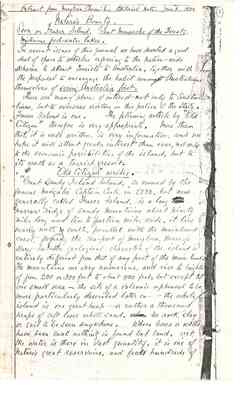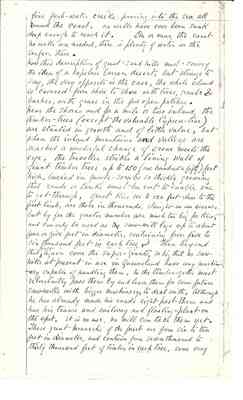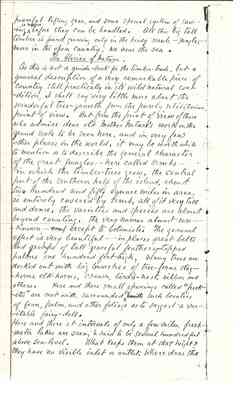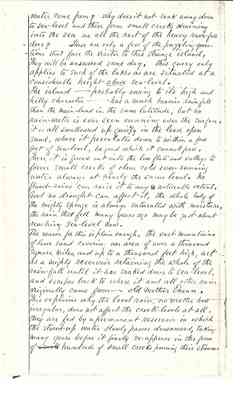Pages
USC65_0002
Extract from Maryboro Chronicle, Editorial note. June 8 1929. Nature's Bounty. Seen on Fraser Island, Giant Monarchs of the Forest. Mysterious fresh-water lakes. In recent issues of this journal we have devoted a good deal of space to articles referring to the nation-wide scheme to attract Tourists to Australia, together with the proposal to encourage the habit amongst Australians themselves of seeing Australia first. There are many places of interest not only to Australians, but to overseas visitors in this portion of the State. Fraser Island is one. The following article by "Old "Citizen" therefore is very appropriate. More than that, it is well written, is very informative, and we hope it will attract greater interest than ever, not only to the economic possbilities of the island, but to it's worth as a tourist resort. "Old Citizen" writes. "Great Sandy Island Island, so named by the famous navigator Captain Cook, in 1770, but now generally called Fraser Island, is a long narrow ridge of Sandy mountains about ninety miles long and ten to fourteen miles wide, it lies neaby north & south, parallel with the mainland coast, forming the sea-port of Maryboro, Hervey's Bay, but the geological character of the island is entirely different from that of any part of the main land. The mountains are very numberous, and rise to heights of from 200 or 300 feet to about 1,000 feet, but except at one small area - the site of a volcanic uppheaval to be more particularly described later on - the whole island is one great heap - or rather a thousand heaps of soft loose white sand. No rock, clay or soil to be seen anywhere. Where bores on wells have been sunk nothing is found by sand, yet the water is there is vast quantity, it is one of nature's great reservoirs, and feeds hundreds of
USC65_0003
fine fresh-water creeks pouring into the sea all round the coast, no wells have ever been sunk deep enough to reach it. On or near the coast no wells are needed, there is plenty of water on the surface there. No wthis description of Great Sandy hills must convey the idea of a hopeless barren desert, but strange to say, the very opposite is the case, the whole island is covered from shore to shore with trees, scrubs & bushes, with grass in the few open patches. Near the shores and for a mile of two inland, the timber-trees (except the valuable Cypress-Pine) are stunted in growth and of little value, but when the inland mountains and valleys are reached a wonderful change of scene meets the eye, the traveller strikes a living wall of giant timber trees up to 150 (one hundred & fifty) feet high, buried in jungle-scrubs so thickly growing that roads or tracks much be cut to enable one to get through, great piles 100 to 200 feet clear to the first limb, are there in thousands, straight-as an arrow. but by far the greater number are much too big for piles, and can only be used as as saw-mill logs up to about four or five feet in diameter, containing from five to six thousand feet in each tree. Then beyond that limit again come the superior-giants, so big that no sawmills at present in use in Queensland have any machin-ery capable of handling them, so the timber-getter must reluctantly pass them by and leave them for some future saw-mills with bigger machinery, to deal with. Although he has already made his roads right past them and has his teams and railway and floating-plant on the sport, it is no use, no mill can take them yet. These great monarchs of the forest are from six to ten feet in diameter, and contain from seven thousand to thirty thousand feet of timber in each tree, some very
USC65_0004
powerful lifting gear, and some special system of saw-ing is needed before they can be handled. All of this big tall timber is found growing only in the heavy scrub - jungle,- never in the open country, nor near the sea. The Glories of Nature. As this is not a guide-book for the timber-trade, but a general description of a very remarkable piece of country still practically in it's wild natural con-dition, I shall say very little more abou the wonderful tree-growth from the purely utilitarian point of view. But from the point of view of those who admire dear old Mother Nature's work on the grand scale to be seen here, and in very few other places in the world, it may be worth while to mention or to describe the general character of the great jungles - here called scrubsin which the timber-tress grow, the central part of the Southern half of the island, about two hundres and fifty square miles in area, is entirely covered by scrub, all of it very tall and dense, the varieties and species are almost beyond counting, the very names almost un-known-excepts to botanists. The general effect is very beautiful - in places great belts and groups of tall graceful feathery-topped palms one hundred feet-high, many trees are decked out with big bunches of three-ferns, stag-horns, elk-horns, crown, birds-nest, ribbon and others. Here and there small openings called "pock-etc" are met with, surrounded by such beauties of fern, palm, and other foliage as to suggest a ver-itable fairy-dell. Here and there at intervals of only a few miles, fresh-water lakes are seen, & said to be several hundred feet above sea-level. What keeps them at that height? they have no visible inlet or outlet, Where does the
USC65_0005
water come from? why does it not soak away down to sea-level and there form small creeks draining into the sea as all the rest of the heavy rain-fall does? These are only a few of the puzzling ques-tions that face the visitor to this strange island, They will be answered some day, This query only applies to such of the lakes as are situated at a considerable height above sea-level. The island - probably owing to it's high and hilly chararacter - has a much heavier rainfall than the main-land in the same latitude, but no rain-water is ever seen running over the surface, it is swallowed up quickly in the loose open sand, where it percolates down to wtihin a few feet of sea-level, beyond which it cannot pass. There it is forced out into the the low flats and valleys to form small creeks of clear cold ever-running water always at nearly the same level. No flood-rains can raise it to any noticeable extent. And no drought can affest it, the whole body of the mighty sponge is always saturated with moisture, the rain that fell many years ago may be just about reaching sea-level now. The reason for this is plain enough, the vast mountain of loos sand covering an area of over a thousand square miles, and up to a thousand feet high, act as a mighty reservoir retaining the whole of the rain-fall until it has soaked down to sea-level and escapes back to where it and all other rain orignially came from - old Mother Ocean. This explains why the local rain, no matter how irregular, does not affect the creek-levels at all. They are fed by a premanent reservoir in which they stored-up water slowly passes downward, taking many years before it finally re-appears in the form of hundreds of small creeks pouring their streams




